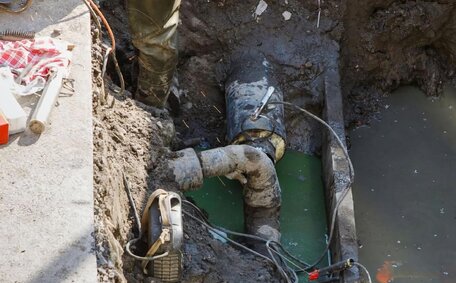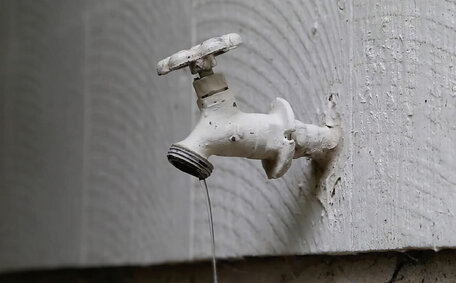What is Pipe Relining and How Does it Work?
Pipe relining is an effective way to repair pipes without the trouble of digging up your property, offering a targeted and thorough solution. It involves inserting a new pipe within old pipes, transforming the existing damaged sewer drain into essentially a new pipeline. This strategy is focused on creating new structures within existing ones and is less invasive than traditional pipe replacement requiring pipeline excavation.
The initial step is a drain camera inspection to evaluate the extent of pipe damage and identify potential areas for inserting the new lining.
After curing, your pipe system is enhanced with a new, sturdy inner liner, increasing its longevity and structural integrity. Epoxy resins can be used effectively for rectifying your blocked drain and pipe relining due to their durable nature and resistance to corrosion. Pipe relining restores flow capacity and effectively addresses leaks, tree root invasions, and cracks, especially beneficial for blocked sewer drains.
The Pipe Relining Process Step-by-Step
Here is a step-by-step overview of the pipe relining process:
- Initial camera inspection - A camera is fed through the pipes so it can inspect damage and locate access points.
- Pipe cleaning - This is how pipe relining begins, with the pipe work being thoroughly cleaned to prepare for the procedure.
- Resin liner insertion - Every pipe relining procedure involves a resin-soaked liner, which is introduced into the damaged section through an access point.
- Liner expansion - The liner is thermally expanded as part of the hot water system, ensuring a tight fit against the pipe’s inner walls and sealing any flaws.
- Curing - Hot water or steam triggers the resin in the liner to harden within the old pipe, solidifying to form a seamless new pipe.
- Final testing - Cameras and pressure tests check the structural integrity of the relined pipe.
- Reinstating service - Once fully cured, flow is restored and the pipe is back in service.
- Post-reline inspection - Cameras inspect the finished lining for quality assurance.
Surpassing traditional methods significantly, pipe relining results in a corrosion-resistant seamless new pipe within the old structure, improving functionality and flow.
Analyzing If Your Pipes Are a Good Candidate for Relining
A qualified plumber will first evaluate your plumbing system to confirm whether the pipes are suitable candidates for relining. There are several diagnostic methods used:
- CCTV camera inspection - Technicians feed a camera through the pipes to visually discern 'common causes blocked drains’ like cracks, intrusions or blockages.
- Pressure testing - Pressurised water is pumped into the pipes and monitored to identify leaks or weak points.
- Pipe material analysis - The plumber examines pipe material, diameter, location and age.
Pipe repairs through relining can remedy sewer storm water pipes compromised by tree roots intrusions, cracks, and corrosion. Sections with 'broken pipes’ or excessive deterioration may not be suitable for the relining process. Your plumber will advise if full replacement is needed.
If suitable, relining provides a method pipe repair for damaged pipes comprehensively and is a minimally invasive solution. Any issues identified during inspection can be addressed prior to the epoxy resin liner being inserted.
This professional analysis ensures pipe relining is only recommended for pipes in adequate structural condition to accept the new epoxy lining.
The Advantages of Trenchless Pipe Relining
Compared to traditional pipe replacement, pipe relining offers numerous advantages:
- Minimal disruption - Trenchless drain repair, as experienced through 'drain relining’, utilises a method pipe that omits the need for yard excavation or harm, ensuring disruption to your landscaping is avoided.
- Speed - Pipe relining jobs are often completed within a single day, providing a quick, convenient solution with minimal hindrance.
- Cost-effective - The cost pipe relining proves to be a more cost-effective solution, saving you 'cost time hassle’, and providing a long-lasting resolution without the inconvenience of traditional pipe replacement.
- Long-lasting - Epoxy liners come with a robust year guarantee, prompting customers to ask how long does pipe relining last - with lifespans ranging from 20 to 50 years.
- Resilient - Compared to traditional pipe repair, relined pipes benefit from a seamless epoxy lining that is highly durable and resistant to corrosion.
- Full pipe capacity - Relining restores flow capacity and water pressure.
- Prevents future damage - The liner provides robust defence against cracks, leaks, tree root intrusions and corrosion.
- Environmentally friendly - Relining reuses the existing pipe, reducing landfill waste.
In summary, pipe relining benefits from being quick, skilled, and minimally disruptive, all while greatly extending the lifespan of pipes. It avoids the mess and costs of full pipe replacement and repairs underground pipes without damage to your property.
What to Expect During the Pipe Relining Process
Here’s an outline of what to expect when your property undergoes pipe relining:
- Equipment setup - The technicians will conduct plumbing services, connecting the property’s pipe access points with hoses and cables from the hot water boiler and CCTV monitor.
- CCTV inspection - A camera will be fed through your pipes so the team can inspect the interior and identify any access points or obstacles.
- Pipe preparation - In preparation for resolving plumbing issues, your system’s pipes are thoroughly flushed and cleaned for the resin liner insertion.
- Resin insertion - The flexible epoxy resin liner coated with a bonding agent is fed through the access point and into your pipes.
- Curing - Hot water or steam is pumped into the pipe to uniformly heat the liner, causing it to expand and cure into a hard, smooth lining.
- Pipe testing - Your pipes are pressure tested and inspected by camera again to ensure no leaks or defects in the new lining.
- Site clean-up - All equipment is removed and the property cleaned up and restored to its original condition.
Our skilled technicians execute the pipe relining process efficiently, quickly ensuring the operation is completed within a timely manner. Access to water and sewer pipes will be temporarily interrupted, but the swift process usually takes just one day — a fact that would highly recommend its efficiency.
Preparing Your Property Before Pipe Relining
- Work area clearance - Ensure that technicians have unhindered access to pipeline endpoints, usually situated outdoors or under sinks by removing obstructions.
- Schedule a plumbing service interruption - Your water and sewer drainage will be unavailable during the 1-day relining process. Plan accordingly.
- Inform tenants - If you have rented properties onsite, notify tenants in advance of the temporary service disruption.
- Unblock access - Ensure technicians can easily access affected pipes. Move furniture or storage boxes if obstructing access.
- Manage pets - Keep pets away from the work area for their safety and to avoid distractions.
No digging or extensive modifications are needed before or after pipe relining, making it a less intrusive solution to meet all your plumbing needs. The process is quick, minimally invasive and does not damage your property or landscaping.
Work area clearance - Ensure that technicians have unhindered access to pipeline endpoints, usually situated outdoors or under sinks by removing obstructions.Schedule a plumbing service interruption - Your water and sewer drainage will be unavailable during the 1-day relining process. Plan accordingly.Inform tenants - If you have rented properties onsite, notify tenants in advance of the temporary service disruption.Unblock access - Ensure technicians can easily access affected pipes. Move furniture or storage boxes if obstructing access.Curing and Finalizing The Pipe Relining
Once the resin liner is in place, the pipe relining Sydney specialists initiate the curing process, a standard practice for remedying Sydney blocked pipes. This sets and hardens the liner as part of the pipe relining service, forming a solid new pipe lining within the old pipe.
There are a few methods used to cure the liner and bond it firmly to the old pipe:
- Hot water is circulated through the liner, uniformly activating and curing the resin.
- Steam is injected into the liner to rapidly heat and solidify the resin.
- UV light - Certain liners utilise UV light exposure to solidify the resin.
As the liner cures, our 'pipe relining services’ ensure it moulds tightly to the interior pipe walls, bonding effectively 'within old one’. Once cured, our specialists focus on 'pipe relining your’ pipes and conduct camera tests to confirm the absence of leaks or flaws, epitomising our comprehensive services. The curing process transforms the resin into a seamless, joint-free lining with high structural integrity to renew your pipe.
With the relining pipe procedure complete, full water flow is restored and your pipe is back in reliable service, lasting for decades. The trenchless process is swift and non-invasive, with minimal impact to your property.
Pipe Relining and Potential Disruption to Your Property
With traditional pipe replacement, yards need to be dug up, driveways broken into, landscaping damaged, and concrete cut through to access and replace pipes. This causes significant destruction to properties.
Pipe relining, on the other hand, only requires small access points to be made into the pipe system. For example, technicians may need to drill an access hole of just a few inches in diameter through a wall or floor into a pipe. But major excavations are avoided.
Here’s 'what need know’ about the pipe relining process: a flexible resin liner navigates narrow access points where the mend on the compromised pipe can carried out. Once in place, steam or hot water cures and hardens the liner. Technicians then simply patch up the small access holes, efficiently fix your plumbing system.
So unlike full pipe replacement in your local area, relining preserves gardens, driveways, landscaping and the integrity of your property – contact us today for more details. The only minor preparation needed is clearing access to pipe endpoints. Overall, pipe relining allows pipes to be renewed with very little disruption to properties.
With traditional pipe replacement, yards need to be dug up, driveways broken intomade into the pipe system.
Protecting Landscating pipelines. Technicians insert flexible resin liners through these access areas, avoiding contact with surrounding plants and features.
Observing the resin liner as it is navigated through access points, cured, and seamlessly integrated, is quite remarkable.
Experts quickly reline your pipes via strategic access points, addressing blocked drains and preserving your property’s landscaping beauty and functionality. Pipe relining minimises disruption to your property by eliminating the need for major excavation and subsequent repair work.
Pipe Relining Cost, Warranties and Lifespan
The cost of pipe relining varies based on the length, diameter, pipe material, and access difficulty. However, relining typically costs less than full pipe replacement; to find out more about the expected costs, contact us today for a precise quote. Reach out to 'us today’, as many pipe relining companies offer extensive warranties on relined pipes.
While the best pipe relining may have a higher upfront cost than spot repairs, it offers greater value over time. The best pipe solution, a seamless epoxy lining, has a lifespan of 50+ years if installed correctly. This compares very favourably to the 20-30 year lifespan of traditional piping.
The long-term durability and warranty coverage provides peace of mind. Pipe relining solutions avoid recurring pipe failures and expensive emergency repairs down the road. Though costs vary, is pipe relining worth it? Absolutely, as relining ultimately saves money over repeated spot repairs while restoring your plumbing for the long haul.






